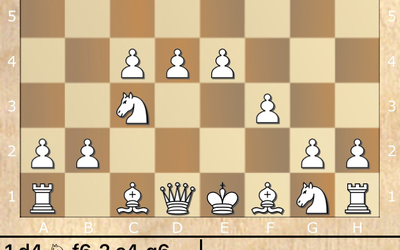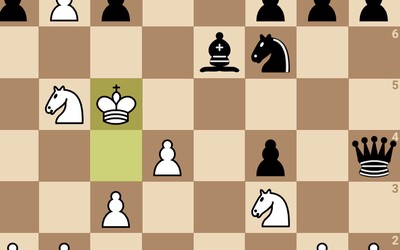
Intriguing examples of voluntary time loss in the opening
Modern chess has become and continues to be an increasingly concrete game. General considerations and strategic dogmas have meant very little in the last several years as long as a concrete point exists. This is something that modern engines have shown to us to no end and it's something that is abundantly clear in the opening. There are various reasons as to why one might want to voluntarily lose a tempo or several in the opening. In this article we will look at several examples on this theme, starting with conventionally accepted forms of time loss followed by stranger and stranger examples after that! Tying into all of this includes an interesting proposal for white with regards to the "burden" of proving an advantage as white.Loss of time in the opening is nothing new; whether it be out of necessity or something voluntary it's still always a bit strange to see. This is normal due to the fact that we are conditioned to avoid such losses of time in favor of development or some sort of coherent plan. However as mentioned above in the introduction, concrete considerations trump everything; modern engines play without bias and consistently spit out ideas that are very concrete yet abstract at the same time. Without a concept of time or some sort of narrative attached to a position the cold-blooded engines will more often than not find ways to make lost tempi workable in a way that fits the position.
With all that being said I'd like to start off by looking at some losses of time that are generally considered acceptable these days.
I am not sure if the idea that Magnus used in the following game was engine-inspired but I certainly remember the stir it caused when it was played: All GM Jesse Kraai had to say about the game on social media was "Be2 h6 Bd3". For what it's worth 7.Bd3 is the engine's top choice nowadays.
Structural considerations play a huge issue in terms of time loss; whether it be provoking an ideal structure as we will see later or the overall context/features of a position. It's well known that in closed positions time is less important, thus giving players a chance to maneuver at their convenience. Knowing this, however anyone seeing the following example for the first time is bound to be surprised at black's retrograde opening scheme
The following idea was actually the inspiration for this article. I was surprised to see 6.Bd3!!?!? as the computer's top choice and even more surprised to see that the idea has actually been played by strong players! The point is to enter a certain structure once the contours of the position have been defined, even after losing a tempo in broad daylight.
The following shows some supplemental games in that structure so readers can compare and understand why white would want such a structure in the first place
This concept below belongs to the great chess thinker M. Chigorin, originating in the early 1900's. Today his idea is a mainstay in several Pirc and Modern lines
GM Ibro Saric opened my eyes to the following idea, not mentioned in most sources that cover the Czech Pirc from white's perspective. I'm not saying it's a total answer for black's long standing woes in the critical 4.f4 variation but it definitely deserves close consideration.
There are several reasons why I love Alexander Grischuk but one of biggest ones has to be his quirky opening preparation. His ideas are unique, clever, deep, and don't overdo anything in terms of being eccentric. A deadly combination in today's game. In this example Grischuk's innocent-looking 6.d3 contains some very deep and hidden ideas, for instance losing a tempo against black's two most critical tries!
Another idea from Grischuk's laboratory that gained some traction can be seen below. Even though the idea of 5.Bg5 h6 6.Bf4!? was seen before from Larsen and others it was not connected with using h6 as a hook to start an attack with g4.
Below is a quirky try vs the Grunfeld that I came across recently. It's nothing special but there are some hidden points. With an opening so solidly reinforced in terms of soundness such as the Grunfeld it's imperative for most Modern professionals to have a rotation of options to check the preparation of the opponent.
Now comes perhaps the most controversial part of this article. To preface the content I think it's important to discuss the traditional narratives surrounding playing white or black in the opening. Long gone are the days where white was guaranteed some sort of "birthright" advantage; modern engines have reinforced as well as revived several lines for black regarded as suspicious or even worse. From this we can extrapolate the following: 1. The safety net in terms of what black can get away with while still maintaining an acceptable position is much larger than previously thought. An example of this can be seen in the number of repertoire courses and books being released from black's perspective these days. This was pointed out by FM Or Cohen in a course he wrote for Modern Chess Magazine. 2. As a result. white has a difficult time proving an advantage against any main line defense. This has changed opening preparation to focus on freshness, comfort, and any other subjective factors that would give one opponent an upper hand over the other.
Consequently it almost feels as if it's easier to be black instead of white in today's modern game. This is an opinion that several players have reflected as we will see in the notes to Carlsen-Svidler. Players such as Suba for instance have pointed out the virtues of playing as black since by moving second black gains information that can be used against white to counter whatever scheme they may try to employ. John Watson in his influential writings has expounded on this by showing examples of how openings with reversed colors and an extra tempo are often toothless as white even if they're dynamic for black. For instance the Semi-Slav can lead to some of the most wild and lively lines of the queen's gambit for black but it often feels bland when white tries to employ the same scheme with an extra tempo in the form of the Colle system.
With all that established I think an interesting solution for white to consider is to play reversed openings, but do so by giving back the whole tempo, essentially surrendering the white pieces and taking on black's role. This might sound strange but this concept has been employed by strong players from time-to-time. However even though the positions and tempi might end up being the same/evened out, it's optically weird to see some of these black openings make appearances under the white pieces.
One of the first times I came across such an approach was during an analysis of the sideline 4.Be2 in the four knights opening. I was intrigued by a game that Grischuk had played at that time but I was having trouble finding something I liked vs the critical 4..d5. It occurred to me though that I could give back the extra tempo and play as black by playing 6.Bb5 which would transpose to the black side of a scotch four knights. All that one would have to do would be to carefully study some model games in the scotch four knights from black's perspective and then white would have a playable weapon vs. 1.e4 e5.
My friend FM Carl Boor from Ohio was probably the first to open my eyes to this idea. He tried 1.c3 e5 2.c4 reaching a Sicilian vs GM Gregory Kaidanov and drew! Later Carlsen famously trotted out this idea on a few occasions.
Thinking about the above two examples during the writing of this article drove my mind wild and made wonder about similar forms of tempo donation after other first moves. Here are some possibilities after 1.d3
And finally 1.e3
All things considered I hope that this article has enhanced the readers' awareness and understanding about loss of time in the opening. I also hope it continues the discussion on many of the interesting opening lines covered here. If you find even one crumb of an idea that catches your fancy I'd be very happy as an author. Let me know what you think!
Sources: https://www.chessgames.com/perl/chesscollection?cid=1000118
Modern-Chess.com
More blog posts by Vitamixbrand

Ecstasy and Agony in the 6.Bc4 Najdorf
Opening preparation these days is a vastly different creature than it was 5-10 years ago. Increased …
Stunners in the Samisch-Benoni/KID complex
The King's Indian Defense is one of the most challenging yet rewarding defenses available to black. …
The Walk of No Shame (Opening Repertoire Ideas for Bongcloud Fanatics)
If you asked several chess players to make a list of the swaggiest things one can pull off in a game…